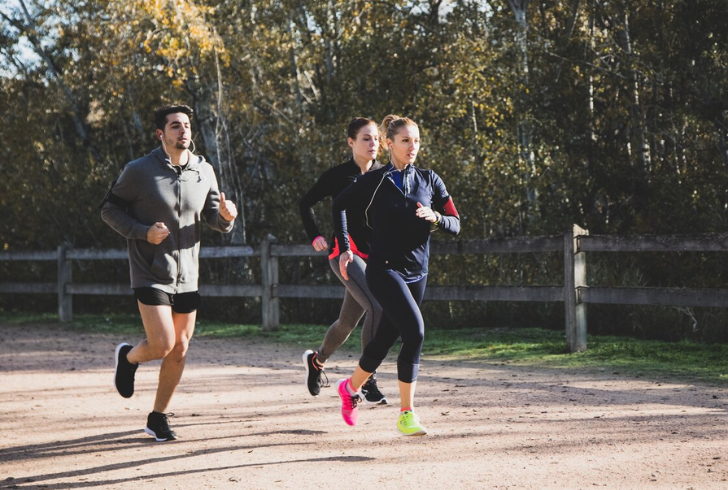
Understanding Health, Fitness, and Performance – A Runner’s Guide

Running isn’t just about putting one foot in front of the other—it’s about aligning your goals with the right training strategies to maximize your health, fitness, and performance. While these terms may seem interchangeable, each plays a specific role in your journey to becoming a better runner. Understanding the differences between health, fitness, and performance can help you tailor your training to achieve your personal best.
Here’s a closer look at how these elements are interconnected and how runners can train for each.
What Is Health in the Context of Running?
Health is the foundation for everything you do, both in running and in life. It encompasses your body’s ability to function properly in everyday activities and its capacity to resist diseases and recover from physical stress. At its core, being healthy means having a well-functioning cardiovascular and musculoskeletal system.

Freepik | Enhanced cardiovascular function results in improved stamina and prolonged running ability.
For runners, health goes beyond just the absence of illness. It’s about maintaining the systems that support longevity and injury prevention. Cardiovascular health, for example, is crucial. Runners who focus on maintaining a strong heart and lungs will notice that their stamina improves over time, enabling them to run longer distances without fatigue.
To maintain good health, regular exercise is key. The Centers for Disease Control and Prevention (CDC) recommends at least 150 minutes of moderate aerobic activity each week, or 75 minutes of vigorous activity. Strength training two to three times a week also supports overall health by improving muscle function and reducing the risk of injury.
The Role of Fitness in Running
Fitness, particularly for runners, refers to the ability to perform activities like running with strength and endurance. This can vary from person to person depending on individual goals, but for most runners, fitness involves improving cardiovascular capacity and muscular strength to support sustained running efforts.
Several factors contribute to running fitness, such as:
1. Aerobic Capacity
This measures how well your body can take in and use oxygen during exercise. A higher aerobic capacity means you can run faster and longer because your body is more efficient at delivering oxygen to your muscles.
2. Anaerobic Threshold
This refers to the point at which lactic acid builds up in the muscles, causing fatigue. Improving your anaerobic threshold allows you to run faster for longer periods without feeling that painful burn.
3. Running Economy
Efficiency is key in running. If you can run at a faster pace while using the same amount of energy as someone else, you’re more economical. This means that improving running economy can lead to better race times without extra exertion.
Focusing on fitness helps runners build a strong base that supports health and enhances performance. As runners improve their fitness, they often experience better endurance, faster recovery times, and fewer injuries.
What Does Performance Mean for a Runner?
When it comes to running, performance is about reaching your peak potential, whether you’re an elite marathoner or someone training for a 5K. It’s about maximizing your body’s ability to perform under specific conditions and achieving your personal goals, whether that’s setting a personal record or simply finishing a race.
Runners with high aerobic capacities can maintain faster speeds over longer distances with less effort. Metabolic efficiency also plays a role in performance. This is the body’s ability to burn fat and carbohydrates at different intensities, which can help you avoid hitting the wall in long races and reduce the need for frequent fueling.
Another important factor is lactate threshold, which affects endurance. Runners with a higher lactate threshold can exercise at higher intensities without lactate building up in the muscles. This allows them to run longer distances or faster speeds with less fatigue.
How to Train for Health, Fitness, and Performance
To train effectively for each of these elements, runners need to approach their training with a well-rounded strategy that incorporates health, fitness, and performance goals.
1. Training for Health

Freepik | prostooleh | Regular aerobic exercises, like cycling are essential for prioritizing good health.
Maintaining good health should always be your priority. Focus on regular aerobic exercises and strength training. Activities such as running, brisk walking, and cycling will help improve your heart health and overall physical condition. Remember, consistency is key to staying healthy.
2. Training for Fitness
To improve fitness, aim to gradually increase your mileage and incorporate higher-intensity workouts like speed drills or hill repeats. These types of exercises push your body to work harder and adapt, building your endurance and strength. Additionally, including cross-training can prevent burnout and overuse injuries.
3. Training for Performance
To enhance performance, it’s essential to define your goals. If you’re training for a race, such as a marathon or 5K, tailor your workouts to improve specific areas like endurance, speed, and strength. Incorporate interval training, tempo runs, and long runs into your weekly routine to prepare for the demands of your race. Additionally, rest and recovery are just as important as training to allow your muscles to rebuild and adapt.
Putting It All Together
Health, fitness, and performance are interconnected, and each one is crucial for every runner. To be successful, you need a solid health foundation, a focus on fitness to improve your running capabilities, and a tailored performance strategy to reach your goals.
By understanding the differences and knowing how to train for each, you can make smarter training decisions that will not only help you run faster and longer but also keep you healthier and injury-free. Whether you’re running for a personal best or just enjoying a regular jog, the right combination of health, fitness, and performance will get you where you want to go.
More inHealthy Trends
-
`
Why Are Men Taller Than Women? New Genetic Study Finds Clue
For centuries, the average height difference between men and women has been noticeable—men generally stand about five inches taller. While environment...
July 23, 2025 -
`
How Upcycled Beauty Ingredients Are Reshaping the Industry’s Future
The beauty industry is going through a big shift — and it’s not just about trends. As waste problems grow and...
July 17, 2025 -
`
A Look Inside Faith Kipyegon’s Groundbreaking Mile Run in Paris
Last week in Paris, Faith Kipyegon returned to a place she knows well: Stade Sébastien Charléty. But this time, she wasn’t...
July 9, 2025 -
`
Dairy Is Making a Major Comeback — And Health Shoppers Are Loving It
Just a few years ago, dairy sat quietly in the back seat while plant-based alternatives took the spotlight. Now, it’s stepping...
July 4, 2025 -
`
Does Aging Cause Dental Problems?
Aging doesn’t automatically mean losing teeth or developing gum disease. In fact, older adults today are holding onto more of their...
June 25, 2025 -
`
How Upcycled Ingredients Are Shaping the Future of Cosmetics
What used to end up in bins or compost heaps is now finding a new life inside skincare bottles and beauty...
June 18, 2025 -
`
Rock Legend Rod Stewart Trains to Break Sprint Record at 80
Age isn’t slowing Rod Stewart down. Known worldwide for his legendary voice, stadium-filling tours, and timeless hits like “Maggie May”, the...
June 11, 2025 -
`
The Truth Behind Detox Diets – Health Boost or Risky Trend?
It’s hard to scroll through your feed without seeing someone sipping green juice with promises of instant energy, glowing skin, and...
June 3, 2025 -
`
Is Dr. Oz Fit to Lead Medicare?
The announcement of Dr. Mehmet Oz as President-elect Donald Trump’s pick to lead the Centers for Medicare and Medicaid Services (CMS)...
May 29, 2025















You must be logged in to post a comment Login